Remembering Walter Gerboth, who had a lively interest in musical humor. Twenty-five years ago, as Music Librarian of Brooklyn College, he took pains to impress this raw beginner with the ideals of the academic profession of music.
Trying to explain a joke—especially a well-known one—can prove a risky business. Still, Time can play its own joke on our understanding and leave us to chuckle at the clownish exterior of some jokes while we miss the point of the profounder humor that lies hidden at their core. Mozart's Musical Joke1 belongs to that class. Audiences laugh at it because it seems ridiculous to hear such lumpishness parading under the name of Mozart; but the truly Mozartean wit and skill of the piece deserve our appreciative attention and hearty admiration. Alfred Einstein, with characteristic insight, remarked in passing that the Musical Joke "provides, in fact, a negative key to Mozart's whole aesthetics."2 Surely such a key deserves more than the passing attention it has thus far received.
Perhaps recalling the service his father had performed for his youthful works, Mozart began keeping his own catalogue of finished work in 1784.3 Although Mozart's autograph score of the Musical Joke bears no date,4 he valued the composition sufficiently to record it faithfully in his catalogue under the date 14 June 1787.5 When he made that entry, the dutiful son cannot have been unaware of his father's relish for just such musical whimsies,6 for Leopold had died a scant two-and-a-half weeks earlier.7 Thus the work seems to date not only from a period in which Mozart commanded his mature skills, but from a time when it seems likely that he would have been inclined to invest even a jeu d'esprit with some degree of sobriety.
Over the course of time, the Musical Joke has acquired a few subtitles: The Village Musicians' Sextet,8The Miners' Music,9 and The Peasant Symphony.10 Such nicknames do the work a disservice, for, while the music does poke some fun at inexpert playing, the modern interpreter must resist the temptation to permit careless or tasteless execution to spoil the joke. Any score that has a right to a Köchel number has a right to the accurate reading that alone can realize its intent and content. As many commentators have pointed out in the past, before everything else, the Musical Joke is a satire of inept composition.
In order to follow the joke, one has to treat the piece as a work of fiction, to pretend (as Mozart evidently did) that it was written not by Mozart but by some imaginary hero: some over-ambitious, small-town Kapellmeister who, as First Violin, leads his minor-league musicians in a performance of his own divertimento, blissfully unaware that it hasn't a trace of the taste and craftsmanship expected by cultivated aristocratic patrons. His inability to meet those expectations forms the heart of the jest.
The opening movement sets out to scale the heights of the conventional sonata-allegro, but, since it loses itself in the foothills, it seems useful to review our map of the territory.11 The classical sonata-allegro procedures begin with the exposition of a primary tonal region (I) explored by one or more primary themes (1P, 2P, etc.);12 a transition section (1T, 2T, etc.) carries us to a new tonality (most often V), usually explored by a secondary theme or themes (1S, 2S, etc.), and then, by means of cadential themes (1K, 2K, etc.) leads us to an emphatic conclusion—not in the original tonality, but in the new one. The irrationality and imbalance of that decisive ending in the wrong key demands redress; the development, therefore, employs modulatory passages to disrupt our memory of the wrong key, to break its hold on our ears and to prepare them to accept a recapitulation of the exposition in the right one. However, if the exposition were to return without change, it would lead us again to that contrasting key and to the same irrational imbalance. Consequently, the recapitulation must now rationalize the exposition in the tonic so that it may serve as an ending in the primary tonal region. The secondary themes (S), previously associated with the contrasting key, must now sound in the same key as the primary themes (P), while the transition will usually have to make some adjustments in order to accommodate the new relationship between the themes.
The spirit of eighteenth-century logic, balance, and clarity pervades these conventions, but not the work of our unenlightened Kleinmeister. His work attains such monumental incompetence that I question whether we dare hope ever to catalogue completely all of its divers faux pas. We may take it as one more mark of Mozart's genius that he could weave so much stupidity into a diverting and instructive fiction. I shall attempt to re-interpret that story here, beginning with that archetypal misconception of sonata-allegro practice.
MOVEMENT I
A hint of trouble sounds in the very first measure, which has a musical content close to absolute zero (see Example 1).
Example 1. W.A. Mozart: Ein musikalischer Spass, KV 522 (Movement I: complete).
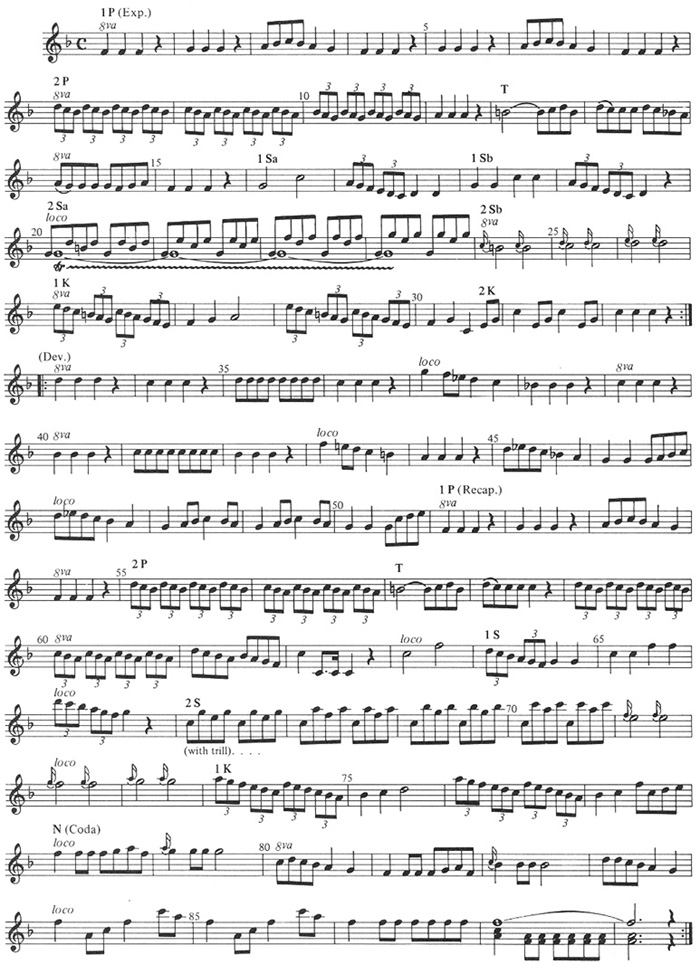
Melodically, rhythmically, and harmonically static, it might have sufficed as the beginning of some fanfare-like announcement (as in the "Prague" or "Jupiter" symphonies), but nothing better follows it. The whole phrase, vapid and directionless, drags itself sequentially upward, says little, and falls back upon itself by the fourth measure, which simply reproduces the first. The fact that three measures of music have filled four measures of real time provides our Kapellmeister with his first opportunity to exercise his particular brand of sophisticated subtlety. Since his end was his beginning (and his beginning truly his end), he can make it do for both as he repeats his opening phrase. With this masterful overlapping he completes his first primary theme (1P), an asymmetrical seven-bar statement in which he has done nothing but clear his throat. In the hands of a Haydn or a Mozart, that asymmetry would propel the music forward, but our hero merely sits down heavily in the wrong chair by adding a four-measure afterthought of utterly vacuous triplets that constitute his second primary theme (2P: mm. 8-11). That theme belongs to the class of gestures I like to identify with the symbol AWOM (= accompaniment without melody). These first eleven measures, harmonized with only three chords (I, IV, and V), constitute our hero's total exploration of the tonic tonal area. It is time, therefore, for a transition.
The simplest transition to the dominant involves raising the fourth scale degree (here, b-natural) to make it the leading tone of the new key. Our hero knows all about raising a scale degree, so he does it—baldly and without preamble (m. 12). Unfortunately, he doesn't know how to keep it raised, so the spark of b-natural sputters out in the very next measure. By the end of his intended four-measure transition he has thudded back to almost exactly where he began.
Having failed to get to the dominant gracefully, our composer goes there anyway. Without preparation, he introduces a secondary theme (1S; mm. 16-17): two measures of near-melody which he repeats immediately with subdivisions he must have intended to pass for elegant variation (mm. 18-19). He follows this with a compound barbarism (2S): four measures of a new AWOM in which the viola plays only a long trill (mm. 20-23). Eighteenth-century ornaments, of course, belong properly to melody rather than accompaniment, and, as Mozart's father had written in 1756, "there is nothing more laughable than a trill held beyond bounds."13 These sensible principles may have had some meaning for our hero since, in the "elegant variation" that follows inexorably, (as if trying to cover his embarrassment) he exchanges the trill for an appoggiatura (the wrong appoggiatura!) and transfers it to the highest part, but without adding anything material to the melodic substance (mm. 24-26). However, as at 1P, a deadly structural ingenuity intervenes, this time to prevent the repetition from completing itself; its last measure disappears under the premature onset (at m. 27) of the overlapping cadential section (K), and the whole asymmetrical hodgepodge arrives at the double bar, with kapellmeisterisch nicety, in exactly 32 measures.
Wonder follows upon wonder. Since the concluding measure of the exposition (m. 32) is functionally equivalent to the first measure of 1P, our composer grasps the opportunity for an even more ingenious overlapping. He takes that last measure of the exposition as the beginning of the development, overlapping his phrase across the double bar, smearing the point of articulation between his exposition and development, and committing himself to the least developable of his themes.
As every beginner knows, all developments must modulate; so does this one. After thumping impotently at 1P a few times (32-36), our hero combines it with modulations of such crudity that they actually sound fresh to our twentieth-century ears (mm. 37-48). He lurches abruptly from C to B-flat to A minor; but, uncertain of what he ought to do there, and even less certain of how to continue, he covers his embarrassment by backing out quickly the way he came in: A minor to B-flat to C, only a step from his goal, and plunges with evident relief into his recapitulation in F (m. 51).
One might expect this recapitulation above all others to fall tritely into place, but it does not. Our hero scorns the waste of time. He proposes to make his restatements more concise by simply cutting his themes in half. The idea works well enough for his first primary theme (1P), which sounds logical at last (mm. 51-54), but it will not work for the second one (2P). Instead of cutting each measure in half and preserving the harmonic logic of his AWOM, he sticks to the same plan and cuts off its last two measures (mm. 55-56 = 8-9). Even that might have worked, had he followed with the second half of the transition; but by using only its first half (mm. 57-58 = 12-13) he places himself again in a situation he does not understand. Only one thing to do: drop it, go back to 2P, and try a new tack. The new transition (mm. 61-62) turns out to be too good. Now that he really wants the tonic, it lands him squarely on the dominant. Serendipitously, this allows him to drop bluntly on the tonic for both secondary themes. He even tries to dress up the second one. After resolving the four-measure viola trill to a dissonance (mm. 67-71), he entrusts the viola with a miscalculated bit of countermelody (mm. 71-74)—but more about this passage later.
It would seem unthinkable for such a composer to conclude without a coda, and he does not disappoint us. He reverts (at m. 77) to his vacuous 1P, which he proceeds to decorate by subdividing the beat with a new gusto. The original asymmetry persists, but now an unbridled counterpoint accompanies it in the bass, racing heedlessly through thickets of dissonant passing tones (mm. 78, 80ff.). Such gaffes become more numerous as the work proceeds, but they rarely become blatant. They direct their humor as much to the experienced taste as to the ticklish ear.
The three final measures crown the movement with a banality unexpected even in this context; but those measures are not as innocent as they look. Our Kapellmeister finishes them with a sign of repetition, having neglected to supply an alternate first ending. He needs one because he has forgotten that he cleverly placed the other double-bar, the one at the end of the exposition, between the first two measures of his theme. Consequently, playing this repeat (and it should be taken) forces a jump from the final tonic to the second measure of the dominant version of the primary theme, producing dislocation for players and listeners alike.
MOVEMENT II
Minuets ought to be tuneful and graceful; ours is military and lumpish. All the same, a snatch of innocent melody—the first in the course of the whole work—strays into the path of the parade (mm. 9-12; see Example 2) only to be trampled under the jackboots with parallel sevenths and other coarse dissonances in the scramble toward the cadence (mm. 32-36).
Example 2. W.A. Mozart: Ein musikalischer Spass, KV 522 (Movement II: mm. 1-95).
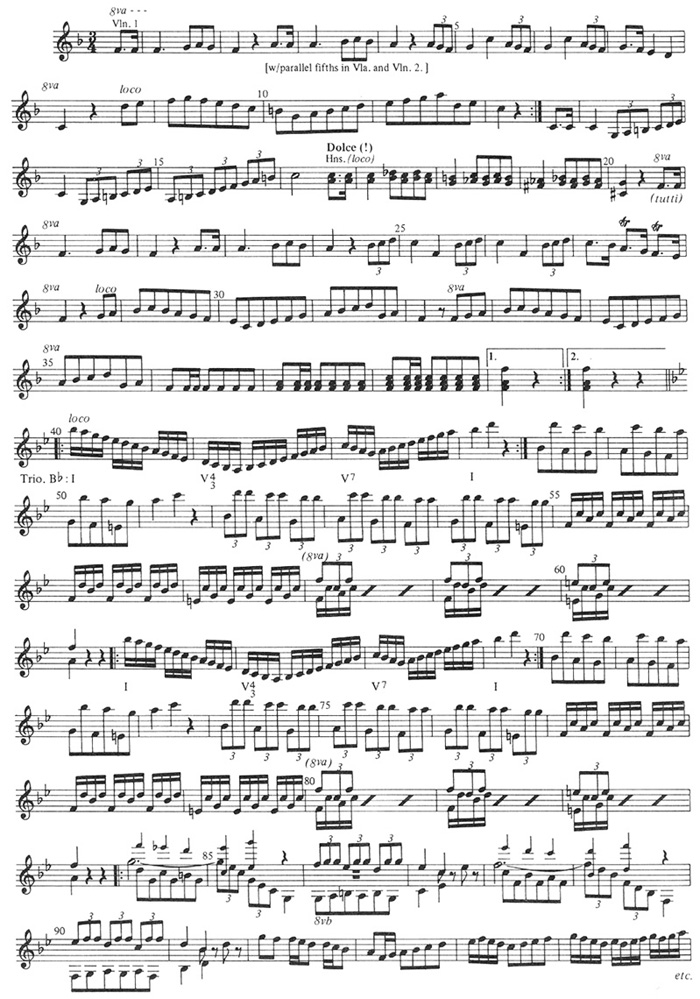
A functional minuet consists of sixteen or thirty-two measures in eight-bar phrases subdivided into units of two or four bars.14 Ours is not a functional minuet. Its opening periods run twelve and twenty-four measures each. It might have ended neatly in thirty-two measures, had not our hero insisted on an obstreperous repetition of his cadence (mm. 32-36) to which he tacks on a three-bar addendum of sheer regimental bombast (mm. 36-39). Moreover, a minuet is usually longer than its trio, but in ours the tail wages the dog: minuet = 39 mm.; trio = 52 mm.
In the midst of all this miscalculation, there occurs one of those merry disasters that lead some to misconstrue the work as a satire of clumsy playing: the valveless horns stray from what should have been a straight path of parallel thirds (mm. 17- 20). But they are not to blame; it is our hero who precipitates the tailspin by marking their parts dolce. Significantly, this is the only affective marking anywhere in the whole work, and it appears in the parts of the players least accustomed to such refinements. Apparently, Horn I interprets the unfamiliar foreign word to mean "open" and, playing all of mm. 17-18 unstopped, he emits the flat-A and sharp-F of the 11th and 13th partials of the natural horn in F. Modern conductors who allow the use of valves to produce the score's written—but unwanted—true A-flat and F-sharp miss the point of the joke. Horn II evidently does know the term dolce, and puffs his way through the correct but unfelicitous alternation of open (O) and stopped (S) notes in measure 17: O-S-O-S-O. However, the blunders of his partner seem to have distracted him for, although he ought to play only open notes in the next bar, he absent-mindedly persists in that same pattern (O-S-O-S-O) throughout measure 18.
At this point, a sudden about-face in the score implies outside interference which we may reconstruct as follows. Our Kapellmeister, becoming aware in measure 17 that Horn I has gotten into trouble, utters some kind of admonition to him in measure 18. But in issuing the warning he prevents himself from hearing that Horn II is also straying into difficulty. Thus, when he hisses something like, "Not that way! The opposite way!" both players respond obediently: Horn I changes from all open tones to its opposite, all stopped tones, while Horn II inverts his pattern—from O-S-O-S-O to its opposite, S-O-S-O-S. Those who find this scenario too complicated must explain why both horn players should suddenly and simultaneously reverse their modes of playing at m. 19. I suggest that the disaster begins and ends with our Kleinmeister, not with his hornists. They vindicate themselves completely when they play the very same notes correctly and triumphantly just before the end of the last movement (mm. 428-436).15
The style of the trio has no connection with the martial manner of the minuet. A connection fails also between the trio's opening finger exercise and the chords that support it. The running scales belong metrically and tonally to duple time, not triple, and seem to teeter on the edge of the supporting harmony (mm. 40-47). Our hero follows this exploit with another empty display: redundant leaps of a tenth which merely reproduce the pitches of the accompanying duet. Then, cannily shifting the accompaniment an octave lower, he repeats himself in triplets (mm. 48-55). Next, AWOM re-asserts itself as a solo in quadruplet sixteenths for the second violin; and when it repeats itself, our hero effects another "elegant variation" by jangling meaningless triplets against the quadruplets (mm. 55-61). Thus he has contrived to display his ability for twenty-two measures without a shred of melody.
As a contrast to the foregoing exhibition of violinistics, our hero now offers us a demonstration of his contrapuntal skills. He proposes to combine four ill-assorted and uniformly vapid subjects, but he can't quite keep more than three of them in motion at the same time (mm. 62-69). As we shall see later, he has a chronic defect in this regard. Here, four bars sequentially repeated prove quite enough for him. They give way to a passage for unaccompanied violin which meanders about unsteadily until it finds its way back to the finger exercises, the leaps, and the jangling triplets. Then the minuet repeats all the previous embarrassments.
MOVEMENT III
If the first two movements starved for want of melodic detail, the third squirms under a glut of it. The horns retire to regroup their forces, while our hero moves to center stage for an aria with cadenza. He will improvise his own embellishments. (See Example 3.)
Example 3. W.A. Mozart: Ein musikalischer Spass, KV 522 (Movement III: mm. 1-14).
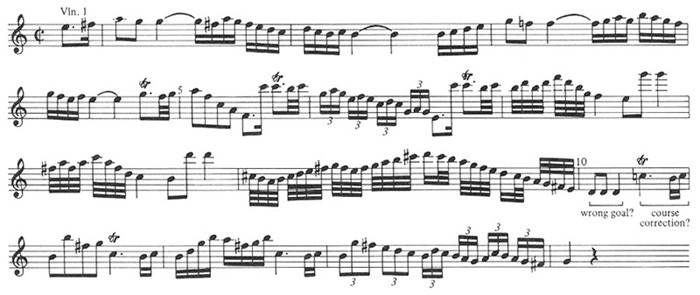
He sets off expansively, but inadvertently, in the direction of G major, thanks to three F-sharps where he should have used only the second. The movement is really in C major. But tonality must look to itself; his mind is set on higher things—literally. Again and again he unleashes florid runs of sixteenth and thirty-second notes, frequently enriched with his ever-ready triplets. Above all, he glories operatically in his high notes which arrive, not at the crown of a melodic arc, but anywhere, unseasonably and inconsequently. He punctuates the sixty-three measures before the cadenza with a dozen of these dazzlers, wherever his melodic line has lost altitude. Indeed, for all his scales, arpeggios, and vertical leaps, his melody doesn't seem to climb, but rather to clamber persistently only to slip back ineffectually.
Under almost every phrase of the aria lies a substructure of melodic non-sequiturs thinly veiled by the pretentious overlay of conventional but ungracefully applied figurations. The very first measure consists of two subtly mismatched particles, the second of which actually repeats the high point of the first.16 That repetition foreshadows the redundancies (like the trilled Cs in mm. 5, 6, 10, 11, and 12) that everywhere lie in wait to block the melody's progress toward fresh goals. Notwithstanding its industrious motion, the aria succeeds only in running in place. As if to proclaim its allegiance to the static, it devotes nine of the twenty-three measures that make up its opening and closing periods (before the cadenza) to the formation of cadences too long and too repetitive for the passages that precede them.
In the middle section, arbitrary modulations drag the ear through half-a-dozen ill-defined keys in scarcely more than twice that number of measures (mm. 24-36; Example 4). And all for nought.
Example 4. W.A. Mozart: Ein musikalischer Spass, KV 522 (Movement III: mm. 23-40).

He has struggled from the tonic of G no farther than the dominant of C, for a net movement of zero. This is thoroughly consistent. Our hero, having failed to effect harmonic development where it was called for in the allegro, blunders into it here where it disrupts the repose that might have been more appropriate in a movement that sets out to be decoratively lyrical.
However, as we have seen, the lyricism is only superficial. The fact that seventeen trills occur in the course of the first 50 measures marks them as the most prominent melodic gestures of the movement. Over a dozen times, trills serve to initiate melodic cells rather than as decorations of their terminations—their proper job (mm. 4, 5, 6, 10, 11, 12, 40, 41, 42, 44, 48, 49, 50); and three of the times in which they serve their proper function they terminate on the wrong note (mm. 30, 32, 34). And although Mozart will have more to say about trills in the last movement, here he allows his protagonist to write a simultaneous trill in three instruments (m. 30).17
The aria is all manner and no matter; that is, it resembles a cadenza more than an aria. What then could seem more likely for our hero than to pile a cadenza on top of his aria? He sets about the business with what must surely rank as the most inelegant, the most cloddish approach to the 6-4 chord ever placed on paper (mm. 60-63; Example 5).
Example 5. W.A. Mozart: Ein musikalischer Spass, KV 522 (Movement III: mm. 60-63).

Through that wide gate he passes only to discover that he has brought nothing with him. Now that he really needs his leaps, his runs, and his trills, he finds that he has squandered his stock of them in embellishing the aria. He begins, therefore, as he must: hesitantly, as if weighing his best course of proceeding. He then launches into a series of Baroque clichés and pilferings from the fiddler's exercise book and eventually runs a string of thirty-second notes all the way up to g'''—the highest note he has yet attained. Flushed with success, he risks an assault on even more exalted heights; but there he is out of his depth—or rather, his altitude. He simply does not know his way across that unfamiliar stretch of the fingerboard. As he edges again toward the g''' and the unknown beyond, he loses his way, his pace slackening as he searches for the correct note. Finally Nemesis strikes, and his scale—now eight times as slow as it began—degenerates into a meaningless series of whole tones that leave him stranded up on d''''. Totally lost, he takes the coward's way out and plunges: he plucks the open G string to reestablish his aural bearings, and, after an eighth rest (which could represent his sigh of relief), he signals his players. The signal should have been the conventional trill, but he begins on the wrong note and with the wrong interval (Example 6).
Example 6. W.A. Mozart: Ein musikalischer Spass, KV 522 (Movement III: mm. 75-77).
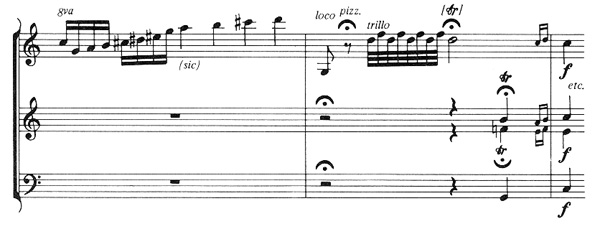
After he adjusts that minor difficulty, the ripieno enters and once again triplicates his trill before bringing this most satirical movement of the four demurely to its close.
MOVEMENT IV
In the final Presto once again the tail wags the dog; this movement exceeds by five measures the combined lengths of the three earlier movements, including all of their repeats.
The snappy but rustic little theme that opens the movement seems to blazon our hero's provincial extraction. The structure of the theme advertises his musical quality (see Example 7).
Example 7. W.A. Mozart: Ein musikalischer Spass, KV 522 (Movement IV: mm. 1-10).
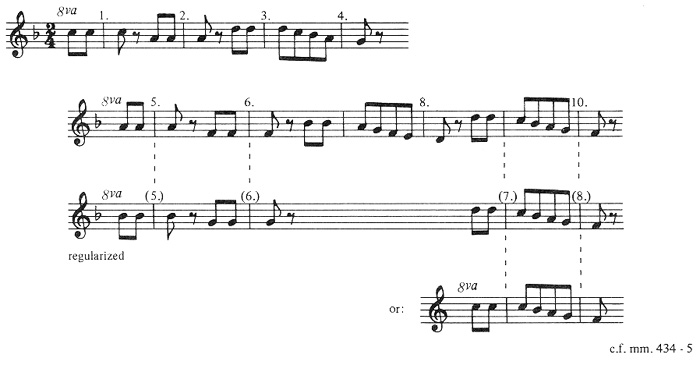
What should have been a simple eight-bar phrase goes awry in its consequent (mm. 5-8) and requires a two-bar afterthought to wrench it home again (mm. 9-10). The second period runs the subject through an overlong series of sequential modulations; but the chain of thirds leads it back not to the tonic, F major, but to F minor (mm. 11-26). Again, that two-bar addendum, unchanged, comes to the rescue by simply quashing the established A-flat and D-flat of F minor.
Having galloped for twenty-eight measures on one brief motive, our hero turns for contrast, as he did in the trio, to the glories of counterpoint. This time he tries his hand at a fugato (mm. 29-44). His subject matches the spirit of his opening theme, but he directs it toward the wrong tonal goal, cuts it off too short and patches in an unimaginative, pre-fabricated textbook answer. Yet not even all these liberties can help our hero keep four voices moving at the same time. The bass gives up before the soprano comes in.
Still, in spite of its repetitiousness, the movement as a whole captures our attention with its brisk, bumptious disdain of transient detail—and without a single triplet. Its spasmodic jerks from idea to idea give it variety and unexpected charm. A few points seem worthy of particular notice.
The horns, having dressed their wounds and adjusted their differences, return to active service. Our little master writes their parts with remarkable confidence, but with his customary lack of insight. He requires them to trill in unison—a muddy effect on valveless horns—for nine asphyxiating measures on a fairly high note (d'' sounding g'; mm. 63-71). Later he requires Horn I to cope with the impractical trill on high g'' (sounding c'') while his partner sustains the low G (sounding c) two octaves below. They play this odd sound for seven measures, to which they must add another four without stopping for breath (mm. 287-293). Our fiddle-playing Kapellmeister has so much breath that he can even demand that his red-faced horns sustain an octave for seventeen measures and go on playing for another six. And he adds insult to this injury by topping off the passage with a fermata (mm. 190-212)!
In our hero's search for contrasting ideas, he stoops, alas, to plagiarism. He introduces his best recollection of a tune by W.A. Mozart: the opening of the Alleluia from the motet Exultate jubilate, KV 158a [K 165] (m. 76; see Example 8).
Example 8. W.A. Mozart: Motet: Exultate Jubilate, KV 158a; 3. Alleluja (mm. 1-8, 9-16).

However, his best recollection is none too good: he merges a pair of identical measures in the antecedent and consequent, crushing Mozart's two balanced phrases into a single unstable one that keeps slipping toward the cadence. All the same, our hero likes it so much that he quotes it, in various transpositions, some dozen times—more often than Mozart. How many more thefts from Mozart this work may contain I cannot begin to guess.
In the eighteenth century, the viola seldom got much respect. Instead of writing independent parts for it, composers often left it to double the cello or violin, but without allowing it to cross those parts into the limelight. Its players were probably not the most reliable members of the eighteenth-century string choir. Small wonder, then, that it becomes the butt of jokes here. In the recapitulation of the first movement, the viola failed to execute the countermelody imprudently assigned to it (mm. 71-74; see Example 9).
Example 9. W.A. Mozart: Ein musikalischer Spass, KV 522 (Movement I: mm. 70-74).

If we assume that our Kapellmeister does know how to read the alto clef, we must charge the error to the violist who, groping for an a'', fingers it on the third string instead of the fourth, and so reaches only a d''. If he had bowed the presumably correct a'', the written rhythms would have allowed a simple scale down to the leading tone without the awkward halt in the middle of m. 73 (see example), and in agreement with the other parts. (Let's say nothing about the notation of the appoggiaturas.)
One place in the Aria (Example 10) tempts one to imagine that the viola arrives a beat too late,18
Example 10. W.A. Mozart: Ein musikalischer Spass, KV 522 (Movement III: mm. 56-58).

and a similar situation in the Presto produces the most joyous snatch of counterpoint in the whole work (see Example 11).
Example 11. W.A. Mozart: Ein musikalischer Spass, KV 522 (Movement IV: mm. 404-420).
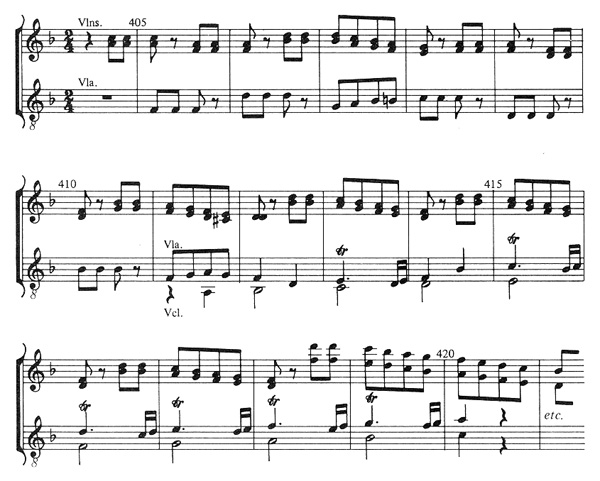
The passage leaves the unmistakable impression of a tardy part trying to catch up to the others.19
The parts finally do get together for a thumping conclusion with the horns in all their glory. Rock-firm, they finally force the awkward ten-bar returning theme into eight-bar regularity (mm. 428-436), and remain immune even when the Goddess of Discord strikes the strings in the final three measures of polytonal disaster (see Example 12).
Example 12. W.A. Mozart: Ein musikalischer Spass, KV 522 (Movement IV: mm. 454-458).
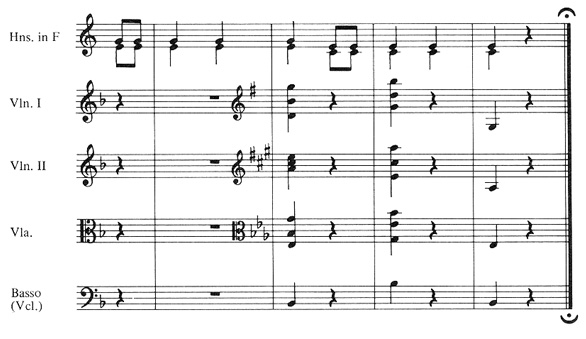
Here at last, in this well known passage, we have unadulterated slapstick. Here we have Mozart dropping the mask and thumbing his nose at upstart musicians and learned analysts alike. It has been a joke, after all, not a dissertation! Nevertheless, despite its faulty progressions, undecorative ornaments, unidiomatic figurations, mismatched melodic modules, interminable triplets, unlubricated passing tones, and who knows how many more as yet uncatalogued solecisms, we may study it with profit because it may help to bring the picture of the real Mozart into sharper focus.
1Ein musikalischer Spass, bestehend in einem Allegro, Menuett und Trio, Adagio, und Finale, KV 522. Edition: Wolfgang Amadeus Mozart, Neue Ausgabe sämtlicher Werke (hereafter MA) Werkgruppe 18: Divertimenti für 5-7 Streich- und Blasinstrumente, ed. Albert Dunning (Cassel: Bärenreiter, 1976), 223-54.
2Alfred Einstein, Mozart: His Character, His Work, trans. Arthur Mendel and Nathan Broder, corrected ed. (New York: Oxford University Press, 1962), 161.
3Both catalogues reprinted as Wolfgang Amadeus Mozart, Verzeichnis aller meiner Werke und Leopold Mozart, Verzeichnis der Jugendwerke W.A. Mozarts, ed. E.H. Mueller von Asow (Vienna: Doblinger, 1956). A facsimile of Wolfgang's catalogue: Wolfgang Amadé Mozart, Verzeichnüss aller meiner Werke . . . (Vienna: Reichner, 1938).
4Dunning, introduction to MA 7.18, p. xv, reports the reappearance of the source, which had been lost since World War II.
5Item no. 62; Mozart, Verzeichnis, 64-65.
6Leopold's exercises in this vein include The Peasant Wedding (Die Bauernhochzeit), The Musical Sleigh-Ride (Die Schlittenfahrt), a Sinfonia burlesca, and probably the Toy Symphony attributed to Haydn.
728 May 1787; Wolfgang probably received word by the 29th of Leopold's death: The Letters of Mozart and His Family, trans. Emily Anderson, 2d ed. prepared by A. Hyatt King and Monica Carolan, 2 vols. (New York: St. Martin's, 1966), 2:908 (letter 547).
8Ludwig Ritter von Köchel, Chronologisch-thematisches Verzeichnis sämtlicher Tonwerke Wolfgang Amadé Mozarts, 6th ed. (Wiesbaden: Breitkopf & Härtel, 1964), 585.
9Ibid., 586.
10Otto Jahn, The Life of Mozart, trans. Pauline D. Townsend, 3 vols. (London, 1882; reprint, New York: Kalmus. n.d.), 2:369.
11We need not trouble about the superficial anachronism of that map. When Charles Rosen (The Classical Style: Haydn, Mozart, Beethoven [New York: Norton, 1972], 30) declares that "sonata form could not be defined until it was dead," he is merely warning us against regarding customary procedures as inviolable rules.
12The symbols used in this discussion derive from Jan LaRue, Guidelines for Style Analysis (New York: Norton, 1970); see in particular Chapter 7, pp. 153-58.
13Versuch einer gründliche [sic] Violinschule . . . (Augsburg: Lotter, 1756; 3rd ed. 1787), 225; facsimile of the 3rd edition, ed. H.J. Moser (Leipzig: Breitkopf & Härtel, 1956). English translation, A Treatise on the Fundamental Principles of Violin Playing, trans. Editha Knocker, 2d ed. (London: Oxford University Press, 1951), 190.
14Meredith Ellis Little, "Minuet," in The New Grove Dictionary of Music and Musicians, ed. Stanley Sadie, 20 vols. (Washington: Grove's Dictionaries of Music, 1980), 12:357.
15For helpful clues that led to the unravelling of this complicated "in-joke" I am indebted to two hornists: Dr. Alfred Blatter, Director of the Department of Performing Arts and Head of the Department of Music at Drexel University, and Mr. John F. Scandrett of Indiana University of Pennsylvania.
16Consulting George R. Hill and Murray Gould, Thematic Locator for Mozart's Works, Music Indexes and Bibliographies, No.1 (Hackensack: Boonin, 1970), makes it apparent that nowhere else does Mozart use four such "atonal" notes to open a movement. However, if we suppress the first ill-advised sharp, we may see some of Mozart's normal continuations in the themes of KV 247/II, 575/II, 617/II, 448b, and 544.
17Even the more decorative Baroque style of half-a-century earlier could not tolerate a surfeit of trills. Johann Mattheson, in Der vollkommene Capellmeister 2.3.35 (Hamburg: Herold, 1739), p. 115, warns that an indelicate excess of trills produces disdain and disgust in perceptive listeners. See also Ernest C. Harriss, Johann Mattheson's "Der vollkommene Capellmeister": A Revised Translation with Critical Commentary (Ann Arbor: UMI Research Press, 1981), 272.
18This passage is parallel with an earlier one (mm. 18-20) in which an earlier entry does not fit, but the parts seem out of kilter. Compare these viola passages with mm. 26 and 30 in the Trio of the Minuet, where Violin II seems to be having the same kind of trouble.
19Observe that beginning in m. 412 of the example the violins mark time with the same passage while the viola tests half-a-dozen cadential trills before settling on one that seems passably synchronized.


